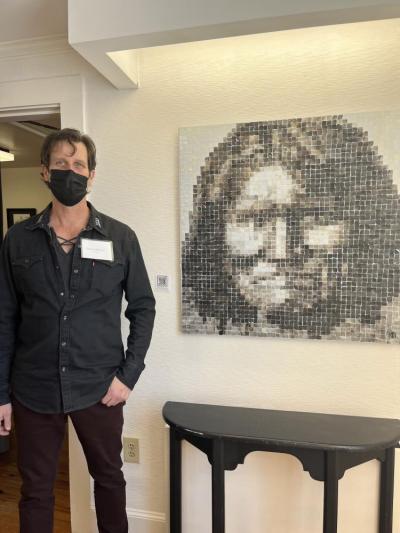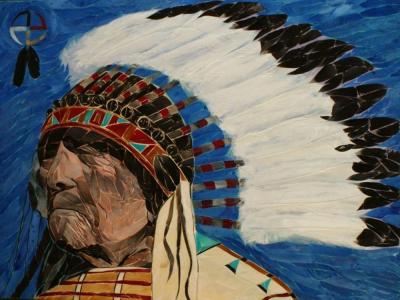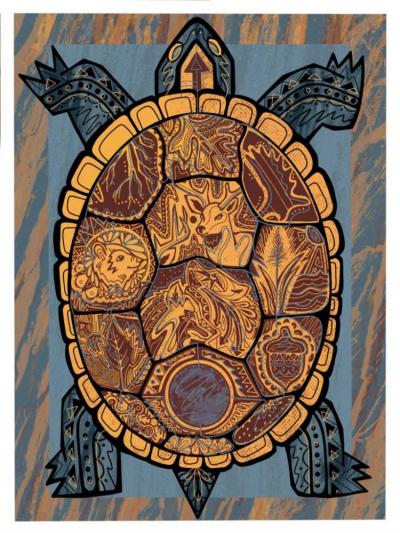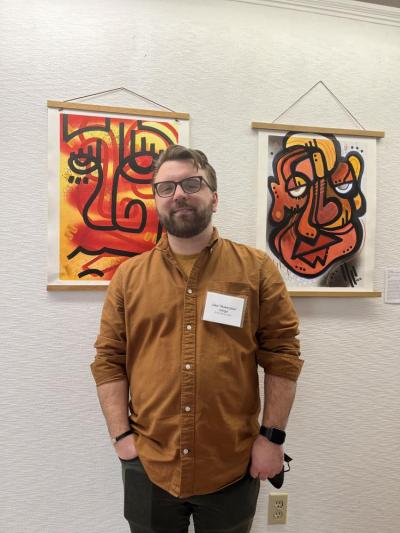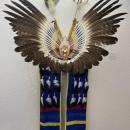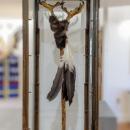Center’s exhibit examines Native American culture through a modern lens
MARION — For many Americans, their first or even only exposure to Native American culture is in history class.
The Exploring Native American Culture exhibition at the Marion Art Center contextualizes the Native American way of life from the perspective of the 21st century.
As visitors enter the gallery, they may not even know where to look first. There are bright colors, intricate designs, and faces of iconic chiefs that stare back at the viewer from the walls.
To curate this experience, Executive Director Jodie Stevens worked with local artist and curator Jess Bregoli to find artists that provided a unique look into the culture with a variety of work in different mediums. The trio of artists showcased are Max Brown-Garcia, Jacob Ginga (aka Makerjake), and Vincent Mancini.
“What I think is really unique about this show is that we have these three very different perspectives,” Stevens said. “I hope this is just the start of us extending our voice to underrepresented populations.”
Stevens explained that for Max Brown-Garcia in particular, showing in a gallery is a very new and different experience. “I don’t know if he even thinks of himself as an artist, but he is a very skilled craftsman,” she said. “His ceremonial regalia is really amazing.”
Brown-Garcia’s work shows his Narragansett culture through his perspective, and his pieces draw attention with their bold texture and color. These include a bustle made of golden eagle feathers, a feathered headpiece, a staff, and other regalia. The exhibit also showcases a beaded necklace that he worked on with his mother, Nancy Brown-Garcia. She is a traditional artist most known for her beading, but also works in other mediums such as leather, feathers, and weaving.
The Marion Art Center is currently in touch with Nancy Brown-Garcia about future collaborations. “We are planning on doing more programming and exhibits about Native American culture, and we hope to bring in Nancy,” Stevens said.
Jacob Ginga is descended from a large and widely known Native American family, and he “occupies the cultural space between his Indigenous ancestors and his traditional middle-class upbringing.” As a child, he grew up going to powwows and wearing regalia, but as he aged into middle school, he started to have a “more traditional White American upbringing.” His artwork is his way of exploring that sense of identity and the “emotionally complicated space” in which he exists.
Ginga didn’t come by the pseudonym of “Makerjake’’ intentionally, he was just trying to hide from his class of high school seniors. He was 21 at the time of his first teaching job, and he didn’t want his students to find him online so, he came up with the moniker to use for all of his social media handles. “It just stuck,” he said.
When Ginga graduated from college, he originally worked with sculpture. The portraiture and prints that the visitor sees on display at the Marion Art Center are the kind of designs he used to doodle for fun. “They’re different, and I didn’t know if people would respond well.”
However, Ginga wound up doing 14 different portraits on a vacation and they all sold in less than a week. It was a big realization for him. “I discovered that people respond well to things that you’re passionate about. I was opening up about something that was a part of me, and people responded really positively.”
Another aspect of Ginga’s work is exploring his culture in the modern space. “I think it’s important to acknowledge that there can be a contemporary side to historical cultures, Native American culture is still changing and evolving.”
That is a big part of Vincent Mancini’s artwork as well. While Mancini isn’t Native American himself, he has a strong reverence for the culture and aspires to break down stereotypes that surround it.
“I’m trying to change people’s expectations and perceptions of Native American culture,” he explained. “Some people believe that they don’t even exist any more. That’s not true.”
Mancini’s work is created through a process called feather lineation. The process involves delineating an image by arranging segments of cut feathers in a geometric pattern. From afar, the piece might look like a painting, but up close the viewer can examine the intricate detail of the feathers.
One of his pieces titled “Geronimo Revisited” took over six months and hundreds of hours of feather lineation. The work recreates an iconic photograph of Geronimo to look more pixelated.
“People recognize him as this famous warrior, but there was so much more to him, he was also a savvy businessman. So, I made the image look like an old black and white television screen to say that if TV was around at the time, he’d be all over it. If Geronimo had the internet? He’d be killing it!”
The Exploring Native American Culture: Art, Craft, and Inspiration exhibit will be open to the public through March 25. Regular gallery hours are 10 a.m. to 2 p.m. Thursday to Saturday, or visit other days and times by calling ahead during office hours, 10 a.m. to 5 p.m. Tuesday to Friday.
Masks are required to enter the Marion Art Center. Visit marionartcenter.org/-on-exhibit for more information.



